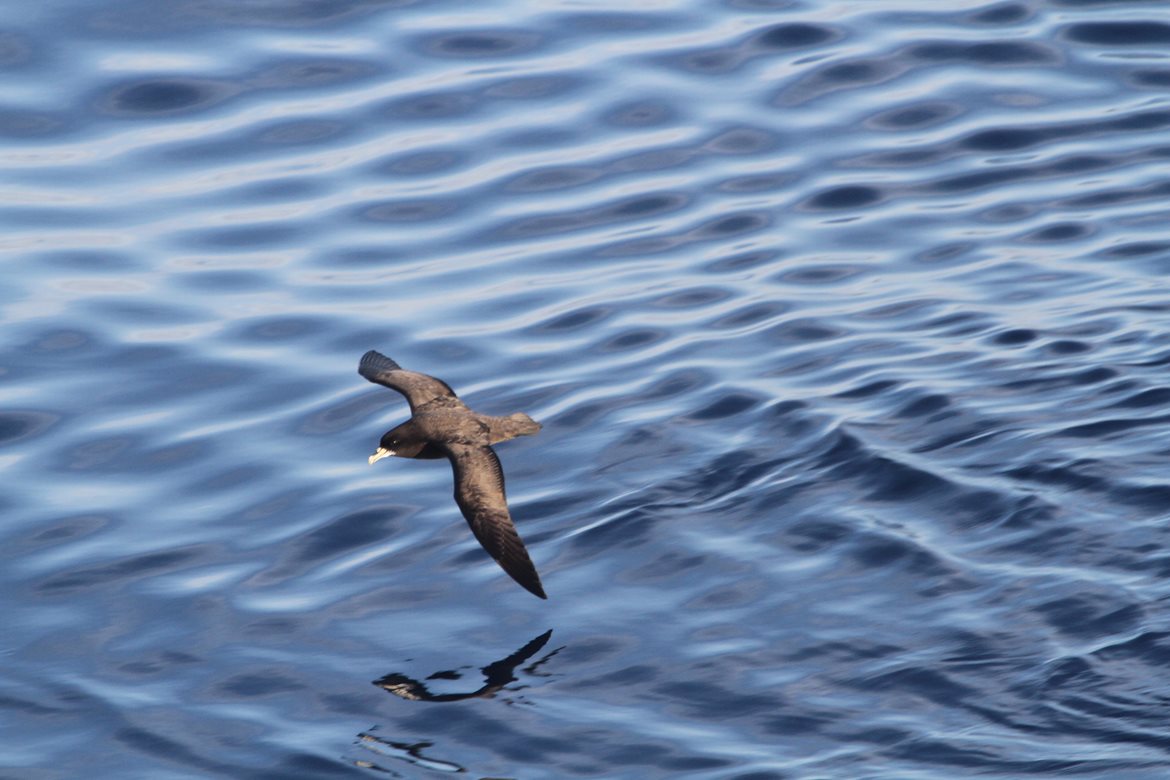
White-chinned petrels in flight near Marion Island in the southern Indian Ocean. Photo: Pierre Pistorius
With many seabird species very sensitive to rising levels of marine plastic pollution, and the large distances they cover during foraging and migration, researchers said that a global study was critical for prevention and conservation efforts.
 Mandela University Marine Apex Predator Research Unit (MAPRU) head, Professor Pierre Pistorius, and his team helped BirdLife International principal investigator Bethany Clark and partners with providing information on the at-sea distribution and behaviour of seabirds in the Southern Ocean.
Mandela University Marine Apex Predator Research Unit (MAPRU) head, Professor Pierre Pistorius, and his team helped BirdLife International principal investigator Bethany Clark and partners with providing information on the at-sea distribution and behaviour of seabirds in the Southern Ocean.
“While we focus on marine predators, one component involves deploying small tracking devices on seabirds, which tells us exactly where they go when away from land,” said Prof Pistorius from the Department of Zoology and Institute for Coastal and Marine Research.
“We’ve tracked various seabird species, included albatrosses, petrels and penguins at South Africa’s Marion Island and some of this data was used in the massive global study of vulnerability of seabirds to plastic pollution.”
There is growing concern about the impact of plastic pollution, he said, and seabirds often ingest small amounts of floating plastic through mistaking it as prey.
“In some cases, these are then fed to their chicks waiting at breeding sites. This can lead to starvation, as the stomach volume is essentially reduced, or poisoning and injury (including stomach scarring).
“Although there have been large numbers of studies looking at how plastic pollution influences specific seabird populations, this one provides the most comprehensive assessment of the exposure of foraging seabirds to plastic pollution globally.”
Seabirds are often very wide-ranging, and the study showed that highest levels of exposure are generally beyond the Exclusive Economic Zones (EEZs) of countries where birds breed, he said.
“This highlights the paramount importance of tackling this problem at a global scale – this is why large, collaborative projects such as ours are of paramount importance.”
According to Nature Communications, which published the study in July this year, seabird species, such as petrels are at higher risk, as they retain plastic for longer periods, owing to the structure of their digestive tract.
The study
A large number of countries were involved in the research, including the United Kingdom, United States, Spain, Mexico, Peru, Australia, Japan and Chile.
MAPRU and the FitzPatrick Institute of African Ornithology, University of Cape Town, were the two South African research teams involved.
Titled ‘Global assessment of marine plastic exposure risk for oceanic birds’, the study investigated the overlap between petrels and ocean plastics, quantifying plastic exposure risk for 77 seabird species on a global scale.
They examined several factors, including individual tracking data, from over 7000 birds in nearly 1 800 000 tracked locations.
The authors compared exposure risks across populations, seasons, and jurisdictions, including the high seas areas outside EEZs that are beyond the national jurisdiction of coastal nations.
Threatened species, such as the Balearic shearwater, Newell’s shearwater, and Hawaiian petrels – were found to have greater exposure risk.
This was particularly concerning for species that are already at higher risk of extinction due to other threats, such as invasive species, fisheries, and climate change.
The authors said that exposure risk primarily occurred outside EEZs where birds breed, and so only mitigating plastic pollution within those zones would not adequately protect most species.
High exposure risks were identified in the Mediterranean and Black seas, as well as in the high seas and EEZs of the USA, Japan, and the UK.
“Marine vertebrates and plastic debris are globally distributed and highly mobile, and cross political boundaries within and beyond national jurisdictions,” the authors said.
“Therefore, mitigating plastic pollution from marine and terrestrial sources will require efforts targeted across multiple jurisdictions and the high seas.
“International cooperation, collaboration, resource mobilisation and information exchange are key to addressing marine plastic pollution by limiting still increasing plastic waste production, improving waste management, and cleaning up existing plastic.”
The authors also argued that global teamwork was key to addressing the impact of marine plastic on a wide variety of species – not only seabirds.
Study leader BirdLife International is the world’s largest nature conservation partnership, with over 115 associated partners in scientific research.
About MAPRU
The Marine Apex Predator Research Unit (MAPRU) is a research unit at Nelson Mandela University. Their research focuses on marine top predators, but ongoing fieldwork has highlighted related conservation issues, such as climate change, overfishing, pollution, declining African penguin populations and the critical importance of establishing Southern Ocean marine conservation areas. For more information, visit https://mapru.mandela.ac.za/
BirdLife International
www.birdlife.org
Bethany Clark, Seabird Science Officer: Twitter @BethanyClark36
Study link
Clark et al. (2023) Global assessment of marine plastic exposure risk for oceanic birds. Nature Communications. DOI: 10.1038/s41467-023-38900-z https://doi.org/10.1038/s41467-023-38900-z –